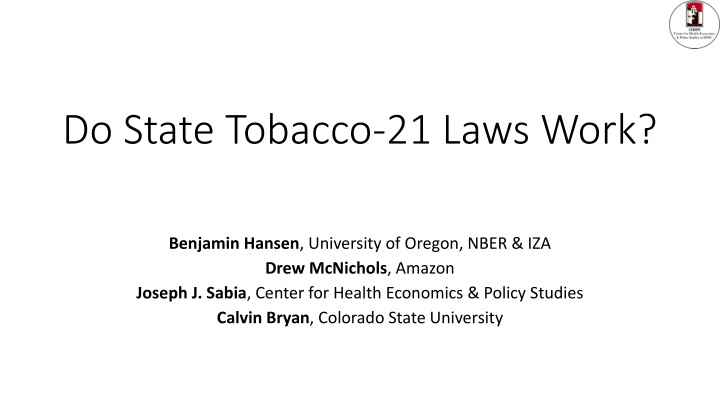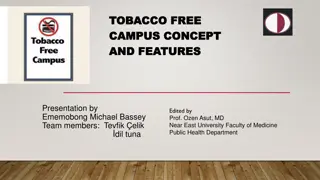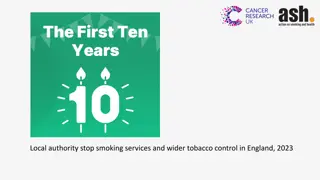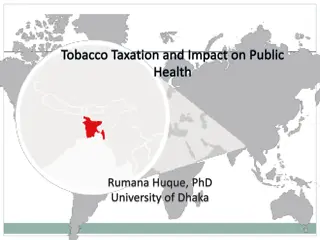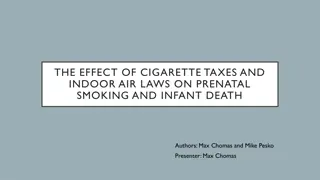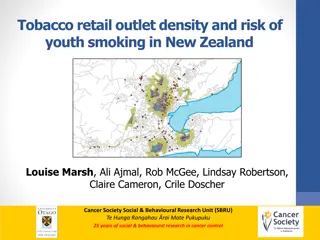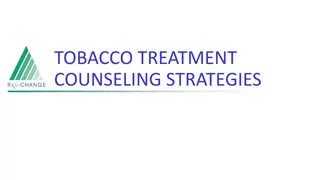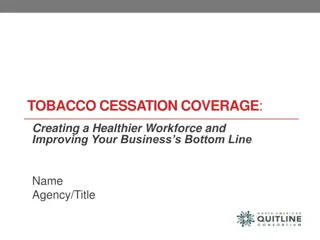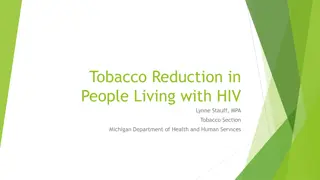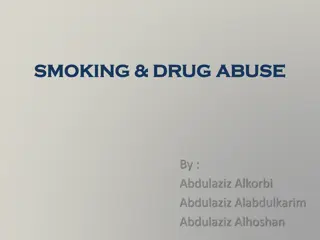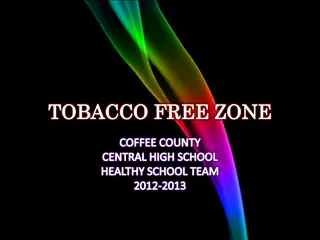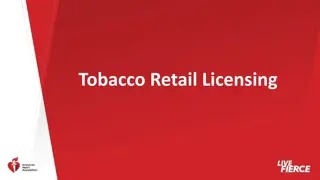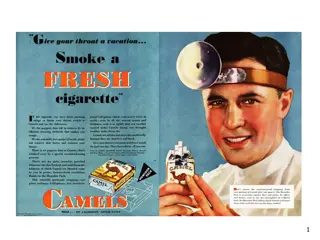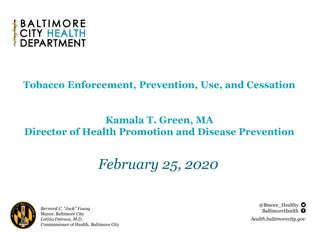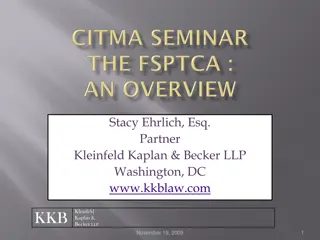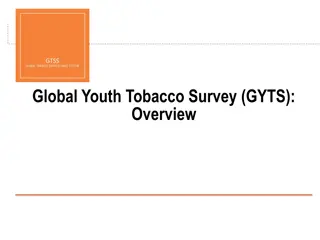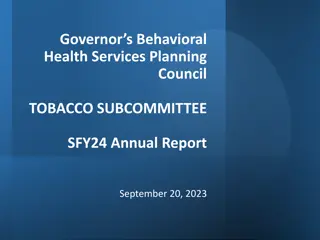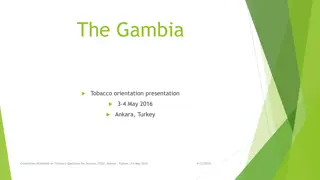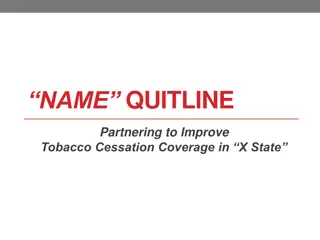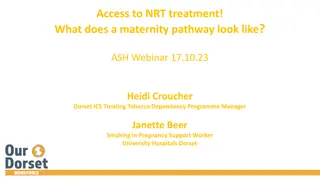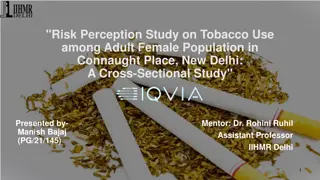Effectiveness of Tobacco-21 Laws in Reducing Youth Smoking
Tobacco-21 laws, which raise the minimum legal purchasing age for tobacco products to 21, are supported by various health organizations due to the detrimental effects of tobacco use. These laws aim to curb youth smoking by reducing access and circumventing issues of tobacco product substitution. Various policy strategies such as clean indoor air laws, advertising restrictions, and excise tax increases also play a role in deterring youth smoking. However, evidence suggests that recent tax increases may be less effective in deterring youth smoking compared to the past, highlighting the need for ongoing evaluation and refinement of tobacco control policies.
Download Presentation

Please find below an Image/Link to download the presentation.
The content on the website is provided AS IS for your information and personal use only. It may not be sold, licensed, or shared on other websites without obtaining consent from the author.If you encounter any issues during the download, it is possible that the publisher has removed the file from their server.
You are allowed to download the files provided on this website for personal or commercial use, subject to the condition that they are used lawfully. All files are the property of their respective owners.
The content on the website is provided AS IS for your information and personal use only. It may not be sold, licensed, or shared on other websites without obtaining consent from the author.
E N D
Presentation Transcript
Do State Tobacco-21 Laws Work? Benjamin Hansen, University of Oregon, NBER & IZA Drew McNichols, Amazon Joseph J. Sabia, Center for Health Economics & Policy Studies Calvin Bryan, Colorado State University
Disclosures This research was supported by the Center for Health Economics & Policy Studies (CHEPS) at San Diego State University, which included research support for a postdoctoral fellow and graduate students from the Troesh Family Foundation and the Charles Koch Foundation. The research team has no conflicts of interest to report.
Motivation Tobacco use is leading cause of preventable death in US 480,000 deaths per year (CDC 2019) Linked to increased risk of heart diseases, cancers (lung, liver, head, colon), diminished respiratory function, and stroke (DHHS 2019) Substantial social costs of tobacco use $200 billion per year in direct health care costs Over $7 billion in external costs (secondhand, third hand) (DHHS 2014) Majority of adult smokers initiate as youths (Everett 1999; Gilliand 2006) Mean age of initiation: 15.3 (CDC 2014) From a social welfare perspective why do we care about young adults? Youth smokers are more likely to have time-inconsistent preferences and give insufficient weight to future addiction costs (Crettez and Deloche 2020) Youths more often fail to account for external costs of private consumption (O Donoghue and Rabin 2001)
Policy Strategies to Curb Youth Smoking Clean indoor air laws (Chaloupka and Eriksen 2008) Restrictions or bans on tobacco advertising (Schroeder 2004) Increases in excise taxes on cigarettes (Carpenter and Cook 2008) Evidence that recent tax increases have been less effective at deterring youth smoking than they were in the past (Hansen et al. 2017; Anderson et al. 2020; Carpenter and Simone 2020) Regulation of electronic cigarette (e-cigarette) market Explosion in the market for electronic cigarettes (e-cigarettes) as an alternative source of nicotine for youths Raising the minimum legal purchasing age to 18 Imposition of electronic cigarette taxes Evidence that there may be unintended consequences of such policies for both adults (Pesko et al. 2019) and youths (Abouk et al. 2021) due to tobacco product substitution
Tobacco-21 Laws T-21 laws raise the minimum legal purchasing age (MLPA) for all tobacco products (i.e., cigarettes, chew, cigars, e-cigarettes) to age 21 Could circumvent problems with tobacco product substitution Laws enjoy the support of American Medical Association (Parks 2016), American Academy of Pediatrics (2015), American Public Health Association (Lowry 2019), Institutes of Medicine (2015), American Heart Association (AHA 2019), American Cancer Society (ACS 2020), American Lung Association (ALA 2020) Wide public support for T-21 laws 74% of all adults, including 64% of smokers and 74% of former smokers
Ages 18-to-20 are critical for addiction While most adult smokers began experimenting with tobacco prior to age 14 (CDC 2020), ages 18 to 20 seem to be a critical time on the path from experimental use from addiction Only 46% of adult smokers became everyday smokers before age 18 while nearly 80% did so before age 21 (DHHS 2014) T-21 laws could be an effective strategy to curtail everyday use and increase successful quit attempts (Khudar et al. 1999)
Timeline of Tobacco MLPA Laws Sources: Alston et al. 2002; Appolonio and Glants (2016)
Toward Statewide T-21 Laws Local Mandates While over 500 municipalities raised their MLPAs throughout the 2000s and 2010s, the localized nature of laws left young adults with a (relatively) low cost means of evasion (Friedman and Wu 2019) One of the rationale for statewide or even nationwide T-21 laws Between 2016 and 2019, 16 states and the District of Columbia adopted statewide T-21 laws Opponents argue that T-21 laws will: Be ineffective (Males 2016) Limit freedom (Bengal 2017), perhaps of those who are rationally addicted Unfair encroachment on freedoms of those able to serve in war, vote, make other important decisions Advocates argue that T-21 laws will: Improve public health (NAM argued national T-21 law will reduce premature deaths by 223,000, lung cancer deaths by 50,000, and reduce years of life cut short for those born 2000-2019) Statewide laws will avoid spillovers, both in terms of tobacco product substitution and evasion Reduce tobacco use among those under age 18 Over three-quarters of 16-17-year-old smokers obtain cigarettes via the social market (i.e., third party purchase, bumming, borrowing, stealing, or another way), including 18yo peers Role modeling effects Fake IDs more difficult to pull off for 16-17 year-olds
Spillover argument echoed by proponents and opponents The most serious threat involves the use of vaping devices for teens under 18 years old. Far too often, 18-year-olds, who are still in high school and can legally buy vaping devices, are sharing them with their younger classmates and the problem isn t only high schoolers. In 2018, there was a nearly 50% increase of middle school students vaping throughout the country. Raising the age limit to 21 presents fewer opportunities for children to get their hands on vaping devices. - Senate Minority Leader Mitch McConnell (R- Kentucky, 2019) Raising the legal minimum wage for cigarette purchase to 21 could gut our key young adult market (17-20) where we sell about 25 billion cigarettes and enjoy a 70 percent market share. - Philip Morris Strategy Brief (1986)
Prior Research on T-21 Laws Studies of local (municipal) T-21 laws Schneider et al. 2016; Silver et al. 2016; Friedman et al. 2019; Friedman and Wu 2020 Key insight: Spillovers may be important If T-21 policy only partially covered a metropolitan/micropolitan statistical area, the estimated effect of T-21 on smoking was about 60% smaller Case studies of state T-21 laws Pennsylvania (Yan 2014) Smoking among pregnant mothers declines (uses an RDD around age 21) California (Schiff et al. 2020; Boettinger and White 2020) Before-after and synthetic control estimates Note that California s law enacted with a bundle of taxes
Contributions First study to examine impact of statewide T-21 laws adopted nationwide First to explore spillover effects of statewide T-21 laws on minors, who rely heavily on the social market for cigarettes Examine the effects of statewide T-21 laws on electronic cigarette use (at a time when JuuL explodes on the market) Descriptively explore effects of statewide T-21 laws on teenagers use of the social market for e-cigarettes First to examine spillover effects of statewide T-21 laws on alcohol and marijuana use
Data Behavioral Risk Factor Surveillance System (BRFSS) Survey, 2009-2019 Treatment group focuses on approximately 95,000 individuals ages 18-20 Cigarette Consumption Measures (0/1) Smoking Participation = 1 if smoked at least 100 cigarettes in lifetime and now smoke everyday or some days; = 0 otherwise 12.3 percent of 18-20-year-olds were current smokers Everyday Smoking = 1 if smoked at least 100 cigarettes in lifetime and now smoke everyday; = 0 otherwise 7.2 percent of 18-20-year-olds were everyday smokers Quit = 1 if smoked at least 100 cigarettes in lifetime and was not a current smoker; = 0 if smoked at least 100 cigarettes in lifetime and was a current smoker 24.9 percent of 18-20-year-olds were successful quitters
Empirical Approach: TWFE Logit ????? = 0 + 1T-21 Lawsmt + Xismt + s + m + t+ ismt ????? is a 0/1 indicator for whether person i residing in state s at month m in year t is a current smoker T-21 Lawsmt is an indicator for whether a T-21 law was in effect Xismtis a vector of controls race/ethnicity, gender, age, age-specific linear time trends, state per capita income, state unemployment rate, state excise tax on cigarettes, clean indoor air laws, whether an electronic cigarette tax, minimum legal purchasing age for electronic cigarettes of 18, state beer taxes, medical marijuana law, recreational marijuana law s, a time-invariant state fixed effect, mis a month fixed effect, and tis a year fixed effect Weighted regressions, standard errors are clustered at the state-level
TWFE Logit Estimates, Ages 18 to 20 Panel I: Smoking Participation -0.029** (0.012) 0.115 Tobacco 21 Law -0.025** (0.012) 0.115 -0.039*** (0.011) 0.115 Pre-Treat DV Mean Panel II: Everyday Smoking -0.020** (0.008) 0.064 Tobacco 21 Law -0.016** (0.008) 0.064 -0.024*** (0.008) 0.064 Pre-Treat DV Mean Panel III: Quit 0.046 (0.053) 0.259 Tobacco 21 Law 0.041 (0.053) 0.259 0.053 (0.058) 0.259 Pre-Treat DV Mean Socioecon & Cigarette Policy Controls? E-cigarette Polices? Alcohol and Marijuana Policies? ***Significant at 1% level **Significant at 5% level *Significant at 10% level Y N N Y Y N Y Y Y
Stacked Difference-in-Differences TWFE logit estimates may be biased in the presence of heterogeneous dynamic treatment effects (Sun and Abraham 2021; Goodman-Bacon 2021) We focus on a more closely balanced panel (in event time) of 4 years of leads and up to 1 year of lagged effects Each stack comprised of states that implemented a T-21 law in the same month-year and counterfactual states that had never implemented a T-21 law Also explored use of not yet adopting states, with a similar pattern of results Include stack-specific state and time effects as well as the controls described above Weighted using product of BRFSS sample weights and number of states in each stack
Stacked DD Logit Estimates, Ages 18 to 20 Panel I: Smoking Participation -0.039*** (0.010) 0.083 -0.038*** (0.010) 0.083 -0.037*** (0.009) 0.083 Tobacco 21 Law Pre-Treat DV Mean Panel II: Everyday Smoking -0.013* (0.007) 0.040 -0.012 (0.007) 0.040 -0.012* (0.007) 0.040 Tobacco 21 Law Pre-Treat DV Mean Panel III: Quit 0.012 (0.072) 0.305 Tobacco 21 Law 0.010 (0.072) 0.305 0.004 (0.073) 0.305 Pre-Treat DV Mean Socioecon & Cigarette Policy Controls? E-cigarette Polices? Alcohol and Marijuana Policies? ***Significant at 1% level **Significant at 5% level *Significant at 10% level Y N N Y Y N Y Y Y
Older Individuals (Less Affected) Ages 24-to-28 Ages 21-to-23
Triple Differences Logit Estimates, Ages 18-20 vs Ages 21-23 Panel I: Smoking Participation -0.007 (0.012) -0.040*** (0.012) 0.115 Tobacco 21 Law -0.001 (0.014) -0.024** (0.010) 0.115 Tobacco 21 Law *Age 18-to-20 Pre-Treat DV Mean Panel II: Everyday Smoking 0.002 (0.009) -0.032*** (0.012) 0.064 Tobacco 21 Law 0.011 (0.009) -0.016* (0.009) 0.064 Tobacco 21 Law *Age 18-to-20 Pre-Treat DV Mean Panel III: Quit Tobacco 21 Law 0.032 (0.031) 0.025 (0.042) 0.259 -0.057 (0.039) 0.045 (0.058) 0.259 Tobacco 21 Law *Age 18-to-20 Pre-Treat DV Mean State-by-Year FE? N Y
Sensitivity of Estimates to Use of Birth Cohort Rather than Age to Define Treatment Smoking Participation Everyday Smoking Quit Tobacco 21 Law -0.011 (0.008) -0.039* (0.022) 0.115 -0.010 (0.006) -0.028 (0.018) 0.064 0.017 (0.023) -0.027 (0.019) 0.259 Tobacco 21 Law * Affected Birth Cohort Pre-Treat DV Mean
Including Local Laws in Definition of Treatment Smoking Participation Everyday Smoking Quit Panel I: Including Local T-21 Laws in Treatment -0.033*** -0.006 (0.012) (0.010) 0.115 0.064 Any Tobacco 21 Law 0.037 (0.045) 0.259 Pre-Treat DV Mean Panel II: Separating State and Local T-21 Laws -0.041*** -0.021 (0.012) (0.009) -0.012 0.029 (0.023) (0.019) 0.115 0.064 Statewide Tobacco 21 Law 0.052 (0.057) -0.007 (0.056) 0.259 Local Tobacco 21 Law Pre-Treat DV Mean
Do border state T-21 policies matter? Smoking Participation Everyday Smoking Quit Tobacco 21 Law -0.038*** (0.011) -0.004 (0.016) 0.115 -0.019** (0.009) -0.022 (0.016) 0.064 0.066 (0.056) -0.055 (0.040) 0.259 Tobacco 21 Law * Border State T-21 Law Pre-Treat DV Mean
Electronic Cigarettes and Age Heterogeneity Age 18 Ages 19-to-20 Panel I: Smoking Participation -0.074*** (0.017) 0.094 Tobacco 21 Law -0.027** (0.014) 0.127 Pre-Treat DV Mean Panel II: E-Cigarette Participation -0.080*** (0.024) 0.095 Tobacco 21 Law 0.012 (0.033) 0.105 Pre-Treat DV Mean
Demographic Heterogeneity in Effects of T-21 Laws on Smoking Participation Below Poverty Line Above Poverty Line Male Female White Black Other HSD No HSD Tobacco 21 Law -0.034** -0.045** -0.056** -0.064** -0.015 -0.033*** -0.084** -0.053** -0.034*** (0.015) (0.018) (0.024) (0.032) (0.019) (0.010) (0.034) (0.024) (0.010) Pre-Treat DV Mean 0.137 0.090 0.146 0.084 0.088 0.101 0.193 0.152 0.101
State Youth Risk Behavior Surveys State Youth Risk Behavior Surveys, 2009-2019 Surveys designed to be representative of risky behaviors of state high school students Can be weighted using SEER to produce nationally representative estimates Explore the impact of T-21 laws on 18-year-old U.S. high school students who are directly bound by mandates Two big advantages Examine spillovers to the youths who depend heavily on social market for tobacco (16-to-17- year-olds in same high schools) Descriptively explore whether T-21 affects usual sources of electronic cigarettes Outcomes Smoking Participation, Frequent Smoking (20 or more days in last month), Everyday Smoking
TWFE Logit Estimates, State YRBS (18-year-olds) Panel I: Smoking Participation -0.030* (0.016) 0.209 -0.021 (0.017) 0.209 Tobacco 21 Law -0.025 (0.016) 0.209 Pre-Treat DV Mean Panel II: Frequent Smoking -0.069*** (0.026) 0.077 -0.069** (0.027) 0.077 Tobacco 21 Law -0.065*** (0.024) 0.077 Pre-Treat DV Mean Panel III: Everyday Smoking -0.051** (0.026) 0.056 -0.051** (0.026) 0.056 Tobacco 21 Law -0.048* (0.025) 0.056 Pre-Treat DV Mean Y N N Socioecon & Cigarette Policy Controls? E-cigarette Polices? Alcohol and Marijuana Policies? Y Y N Y Y Y
Stacked DD Logit Estimates, YRBS (18-year-olds) Panel I: Smoking Participation -0.022 (0.021) 0.197 -0.018 (0.022) 0.197 Tobacco 21 Law -0.009 (0.019) 0.197 Pre-Treat DV Mean Panel II: Frequent Smoking -0.036* (0.019) 0.073 -0.036* (0.019) 0.073 Tobacco 21 Law -0.034* (0.039) 0.073 Pre-Treat DV Mean Panel III: Everyday Smoking -0.039* (0.023) 0.054 -0.038* (0.023) 0.054 Tobacco 21 Law -0.039 (0.024) 0.054 Pre-Treat DV Mean Y N N Socioecon & Cigarette Policy Controls? E-cigarette Polices? Alcohol and Marijuana Policies? Y Y N Y Y Y
Heterogeneity in Effects by Gender and Race Male Female White Black Panel I: Smoking Participation 0.009 (0.024) 0.166 -0.043 (0.031) 0.252 Tobacco 21 Law -0.055** (0.023) 0.249 -0.066* (0.040) 0.130 Pre-Treat DV Mean Panel II: Frequent Smoking -0.021 (0.031) 0.056 Tobacco 21 Law -0.101** (0.041) 0.096 -0.113** (0.052) 0.112 -0.045 (0.052) 0.051 Pre-Treat DV Mean Panel III: Everyday Smoking -0.021 (0.049) 0.041 -0.074* (0.043) 0.083 Tobacco 21 Law -0.072** (0.034) 0.070 -0.076* (0.043) 0.040 Pre-Treat DV Mean
Spillover Effects to 16-to-17 Year-Olds Female White Black All Male Panel I: Smoking Participation -0.028 -0.028** (0.020) (0.014) 0.151 Tobacco 21 Law -0.028* (0.014) 0.135 -0.035** (0.017) 0.164 -0.024 (0.027) 0.068 0.118 Pre-Treat DV Mean Panel II: Frequent Smoking -0.014 (0.009) 0.034 Tobacco 21 Law -0.011 (0.008) 0.042 -0.012 (0.015) 0.051 -0.053** (0.027) 0.060 -0.028 (0.029) 0.018 Pre-Treat DV Mean Panel III: Everyday Smoking -0.005 (0.007) 0.024 Tobacco 21 Law -0.005 (0.005) 0.031 -0.006 (0.011) 0.038 -0.040** (0.019) 0.045 -0.006 (0.025) 0.014 Pre-Treat DV Mean
What about Effects of 14-to-15-Year-Olds? Panel I: Smoking Participation -0.010 (0.009) 0.079 -0.006 (0.008) 0.079 Tobacco 21 Law -0.009 (0.009) 0.079 Pre-Treat DV Mean Panel II: Frequent Smoking -0.009 (0.007) 0.019 -0.007 (0.007) 0.019 Tobacco 21 Law -0.007 (0.007) 0.019 Pre-Treat DV Mean Panel III: Everyday Smoking -0.004 (0.007) 0.013 -0.003 (0.007) 0.013 Tobacco 21 Law -0.002 (0.006) 0.013 Pre-Treat DV Mean Y N N Socioecon & Cigarette Policy Controls? E-cigarette Polices? Alcohol and Marijuana Policies? Y Y N Y Y Y
E-Cigarette Consumption (1) (2) (3) (4) (5) 18-Year-Olds 16-to-17-Year-Olds Panel I: E-Cigarette Participation -0.117** (0.047) 0.176 0.176 Tobacco 21 Law -0.081* (0.042) 0.243 -0.063 (0.047) 0.090 (0.062) 0.126 0.083 (0.064) 0.126 Pre-Treat DV Mean Panel II: Frequent E-Cigarette Use -0.069 -0.073* (0.042) (0.041) 0.048 0.048 Tobacco 21 Law -0.053* (0.030) 0.054 0.029 (0.037) 0.024 0.027 (0.039) 0.024 Pre-Treat DV Mean Panel III: Everyday E-Cigarette Use -0.058 -0.067* (0.036) (0.037) 0.037 0.037 Tobacco 21 Law -0.052** (0.024) 0.043 0.034 (0.035) 0.014 0.029 (0.035) 0.014 Pre-Treat DV Mean Years Policy Controls? 2015-19 Y 2017-19 N 2017-19 Y 2017-19 N 2017-19 Y
Multinomial Logit Estimates: Usual Source of E-Cigarettes Age 18 Age 16-17 Panel I. Direct Purchase -0.170*** (0.041) 0.109 Tobacco 21 Law -0.157*** (0.029) 0.109 0.030 (0.029) 0.018 0.047 (0.035) 0.018 Pre-Treat DV Mean Panel II: Third-Party Purchase -0.028 (0.016) 0.007 Panel III: Borrowing 0.176** (0.072) 0.035 Tobacco 21 Law -0.018 (0.014) 0.007 0.020 (0.021) 0.014 0.002 (0.023) 0.014 Pre-Treat DV Mean Tobacco 21 Law 0.105 (0.064) 0.035 0.063* (0.033) 0.059 0.045 (0.032) 0.059 Pre-Treat DV Mean Panel IV: Internet, Stole, or Some Other Way -0.001 (0.050) 0.026 2017-19 Y Tobacco 21 Law 0.007 (0.047) 0.026 2017-19 N 0.003 (0.007) 0.025 2017-19 N -0.007 (0.010) 0.025 2017-19 Y Pre-Treat DV Mean Years Policy Controls?
Spillover Effects to Youth Marijuana Use (YRBS) Panel I: Marijuana Use -0.052*** (0.020) 0.276 Tobacco 21 Law -0.035 (0.022) 0.276 -0.052*** (0.019) 0.276 Pre-Treat DV Mean Panel II: Frequent Marijuana Use -0.041** (0.019) 0.129 Tobacco 21 Law -0.035** (0.018) 0.129 -0.049*** (0.019) 0.129 Pre-Treat DV Mean Socioecon & Cigarette Policy Controls? Marijuana Polices? Alcohol Policies? Y Y N Y N N Y Y Y
Spillover Effects to Alcohol (YRBS) All Males Females Panel I: Alcohol Use 0.045 (0.045) 0.477 Tobacco 21 Law 0.052 (0.049) 0.460 0.060 (0.064) 0.442 Pre-Treat DV Mean Panel II: Alcohol Use > 2 Days in Last 30 Days | Drinking = 1 -0.085* -0.147** (0.047) (0.069) 0.598 0.661 Tobacco 21 Law -0.021 (0.053) 0.522 Pre-Treat DV Mean Panel III: Frequent Binge Drinking | Binge Drinking = 1 -0.100** -0.097 (0.045) (0.065) 0.222 0.244 Tobacco 21 Law -0.109* (0.060) 0.188 Pre-Treat DV Mean
Spillover Effects to Alcohol (BRFSS) All Males Females Panel I: Alcohol Use -0.016 (0.018) 0.370 Tobacco 21 Law -0.018 (0.016) 0.353 -0.017 (0.029) 0.334 Pre-Treat DV Mean Panel II: Number of Days of Alcohol Use -0.385** (0.143) (0.189) 1.989 Tobacco 21 Law -0.214 -0.005 (0.232) 1.608 Pre-Treat DV Mean 2.316 Panel III: Number of Days of Alcohol Use | Drinking = 1 -0.329 -0.820* (0.337) (0.475) 5.644 6.269 Tobacco 21 Law 0.190 (0.408) 4.832 Pre-Treat DV Mean
Conclusions: Who Cares? The Federal Tobacco to 21 Act was passed in December 2019 It will be at least somewhat difficult to disentangle the effects of the Federal T-21 law (which has not yet been fully implemented) from heterogeneous effects of the COVID-19 pandemic across states where it did and did not bind This study provides important and perhaps the best evidence we will have on the effects of T-21 laws Our results provide strong evidence that statewide T-21 laws are associated with important reductions in tobacco use among 18-to-20-year-olds Includes both traditional cigarettes and e-cigarettes Spillover effects to minors Some suggestive evidence that access to the informal social market blunts the impact of T-21 laws on e- cigarette use among some 18-year-olds
Discussion At present, the US is one of only a handful of counties to have a nationwide T-21 law Ethiopia, Honduras, Philippines, Sri Lanka, Uganda, and US US has far lower smoking rates than most OECD counties, so not clear on generalizability of this study internationally Effects of T-21 laws are likely to vary with a number of factors Local prices Auditing programs to verify compliance with age requirements Magnitudes of fines Internet purchases (where age verification less) and cross-state border shopping (Merriman 2010; Goolsbee et al. 2010)
Will T-21 will be a long-run public health success? U.S.-based tobacco companies endorsed T-21 in the end Why? Perhaps to avoid regulation of flavored tobacco products (Myers 2019) Revealed preference might suggest greater profits associated with less regulation of e-cigarettes Losing sales to 18-20-year-olds may be worth retaining current and future smokers through flavored e- cigarettes Some attribute to JuuL products having high nicotine content, appealing flavors, and more easily concealed (FDA 2018) Dramatic tobacco market changes matters for designing optimal future policy Master Settlement Agreement is 25 years old Dramatic shift from traditional cigarettes to e-cigarettes Advertising and targeting youths has moved to social media and distribution to online markets Long-run impacts of T-21 will depend, in part, on how policy responds to changing markets and technological developments (both for evasion and enforcement)
